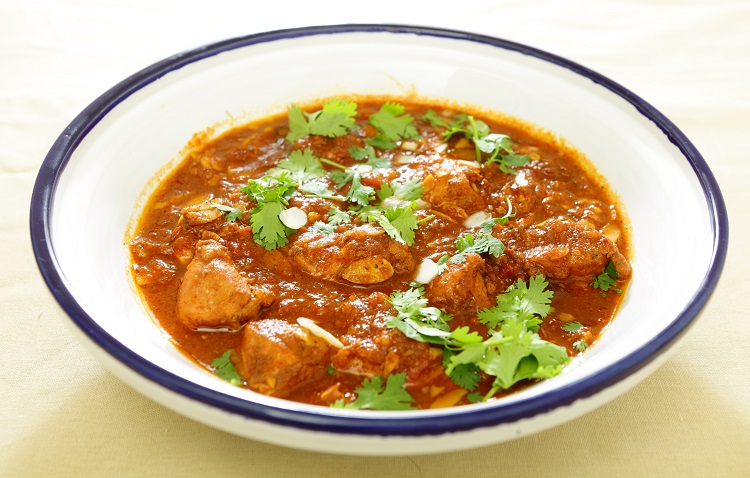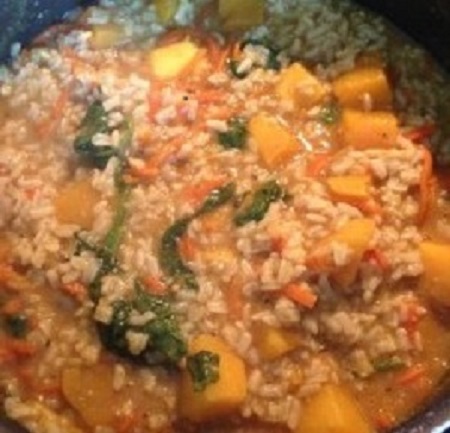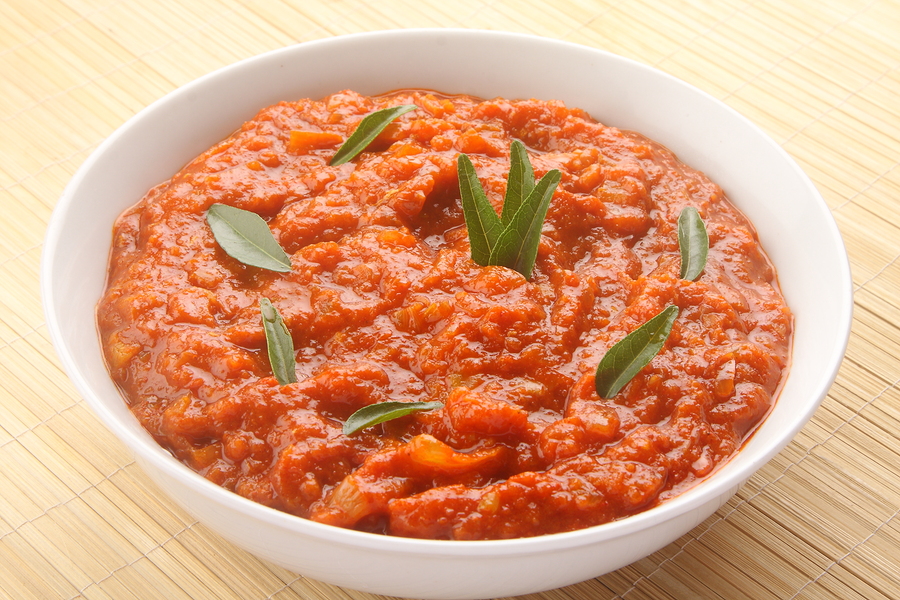A exotic, simple, and delicious stew with synergistic superspices to optimize taste and health. Low-carb, Paleo, and keto-friendly.
Click to get more Easy, Healthy Recipes
Preparation Time
10 minutesCooking Time
1 hourDifficulty Rating
1Health Level
4Serves
8

Ingredients
- 4 chicken breasts (total 2 lbs / 1 kg), preferably organic pastured, halved - with skin for keto version
- 1 onion, finely chopped
- 3 cloves garlic, sliced or crushed
- ½ tsp / 1 g ground ginger
- 2 tsp / 6 g ground cinnamon
- 1 tsp / 3 g additional mild seasonings to taste (e.g., turmeric, sweet paprika, cumin, coriander)
- ¼ tsp / ½ g cayenne pepper (optional)
- 30 oz / 850 g chopped stewed tomatoes, preferably from carton
- ½ cup / 120 ml chicken or vegetable stock, preferably organic low-sodium
Directions
- Add all ingredients to a large saucepan
- Cover and simmer gently for approximately an hour.
- The chicken should be tender and sauce reduced and thickened.




Im new to the group. Some of these spices ive never heard of would all supermarkets have them ..
Hi, Wolfe1971. Yes, they are fairly common seasonings. If you can’t find all of them, don’t worry about it – the recipe will still turn out fine.
I am new to the Keto diet. The recipes look great but why does it not list the calories in each dish? Thanks.
Hi, Ruby2950. The keto recipes do have the calories listed near the top. This recipe is part of our regular low-carbohydrate route, so we list only the exchanges per serving at the end of the recipe. Exchanges here are like those used by diabetes and dietetic organizations around the world, with the following approximate nutritional values:
1 carbohydrate exchange = 15 grams of carbohydrates + up to 3 grams of protein
1 protein exchange = 7 grams of protein + up to 5 grams of fat
1 fat exchange = 5 grams of fat
1 fruit exchange = 15 grams of carbohydrates
1 vegetable exchange = 5 grams of carbohydrates + up to 2 grams of protein
1 sweet exchange = up to 15 grams of carbohydrates + up to 5 grams of fat
1 free exchange = up to 5 grams of carbohydrates or up to 2 grams of protein or fat
Hey I love this recipe I may make it either March 13 2019 or March 14 2019 But it says put everything in a saucepan for 1 hour. I have a Rachael Ray pot. Can I use that? Also Can I put the chicken in my power air fryer? If I can put the chicken in my air fryer then how long do i put everything else in my pot?
Hi, alphamale8071. Yes, you can use a Rachael Ray pot, as long as it holds what is necessary. You absolutely can put the chicken in your air fryer – then you can add it to the rest of the ingredients and simmer for just 15 minutes.
Is there a way to book mark favorite recipes or create a personal recipe box?
Hi, tm2112. The best way is to create one in your regular web browser.
How many pounds are in the chicken breast?
Hi, AdamsBezerra1. Each skinless chicken breast is about 1/2 lb, so this recipe calls for about 2 lbs total.
Hi, I am really new to this club and have a few questions…
1. How do the measurements look in grams please?
2. The recipe looks fab and would like to try it for dinner but am a bit confused about the portion sizes, when you say 1/2 chicken breast, how many grams would that refer to as the chicken breast portions here in the UK vary in size?
3. What is carb exchange?
Hi, Jessy, and welcome! Most of the ingredient amounts are listed in metric units (see the amounts after the slashes “/”). Chicken breasts generally weigh 272 grams without the skin and bones, so 1/2 would be 136 grams. A carb exchange equals any amount of starchy food that yields about 15 grams of carbohydrate and up to 3 grams of protein, without fat. You can see how that translates to food portions here: http://www.trimdownclub.com/exchanges-lists.
I’m really confused what’s the purpose of exchanges.
Hi, Elijanaustinzachaubreysmom. The exchange system is a way of grouping nutrients into relatable food portions (exchanges) to build balanced menus that meat your nutritional needs. They are favored by diabetes organizations. Each exchange is equal to the following approximate values:
1 carb exchange = 15 grams of carbohydrates + up to 3 grams of protein
1 protein exchange = 7 grams of protein + up to 5 grams of fat
1 fat exchange = 5 grams of fat
1 fruit exchange = 15 grams of carbohydrates
1 vegetable exchange = 5 grams of carbohydrates + up to 2 grams of protein
1 sweet exchange = up to 15 grams of carbohydrates + up to 5 grams of fat
1 free exchange = up to 5 grams of carbohydrates or up to 2 grams of protein or fat
You can see the exchanges allotted to you for each meal and day by clicking on the “Exchange mode” icon in the toolbar above your menu.
How do I add this recipe to my Menu Planner?
Hi, Lisa. If you use the personal version of the Menu Planner application (access it by clicking on the “My Food Choices icon in the toolbar above your current menu), you will see some of our recipes in the “Recipes” subcategory of each major food group. For newer recipes that have not yet been added into the system, you can use them to substitute for the main ingredient in your meal. You can also match up the exchanges visible at the end of each recipe and when you click on “Exchange mode” in the toolbar above your menu. It doesn’t need to be a perfect match to work.
Thanks Ossie, this was a delicious meal, enjoyed by all my family 🙂
I m going to try again this looks very nice am going to try it
Was wondering if healthy TV dinners are okay and is there any that are better than the others? ?
Hi, nachomama. TV dinners tend to be troublesome when it comes t o health, because most are full of artificial chemicals and/or too much salt and refined grain products.
Trader Joe’s and Whole Foods Market have some TV dinners that are OK once in a while, but it is ideal if you cook your own foods and freeze portions for later heating and eating.
Just done my 8 weeks now i am looking forward to try ing the recipesthis one because my husband and i love curries.
I’m a bit confused working out the exchange.
Serving size: ½ chicken breast + 1 cup / 240 ml stewed vegetables
Exchanges per Serving: 3 Protein:
this has veg as well, don’t you count that? Only says protein
Hi, Kymbo. There is indeed a vegetable exchange here.
Can I use frozen chicken breasts ?
Hi, Bettyboop. Definitely! What we particularly recommend is pastured chicken if you can get it.
can I use chicken bought from shoprite?
Hi, h11b. Shoprite does appear to have a selection of grass-fed and pastured animals products. If you can find that type of poultry, it would be ideal.
Can I make it up and put if in freezer so I can make up different receipts in the freezer so that I can just take out and heat up as I don’t always have time to cook
Hi, Michelle. Absolutely!
Looking at your recipes I’ve found they are for 8 to 12 servings. I am a single person do you not have recipes for 2 to 4 servings.
Hi, Trimn752017. We do have some recipes for 2-4 servings, but even better, we have a reference you can use to right-size – http://www.trimdownclub.com/reducing-the-size-of-recipes.
Just had this served with a small portion of rice, taste very good
Do I cook the chicken/ fry first or put it raw with all the ingredients?
Hi, emzgriff. Put it in raw with the other ingredients. It will be cooked for an hour – no worries! 🙂
Thanks, just about to give it a go 🙂
Hi I am new and love the look of many recipes to choose from. This
chicken looks delicious but why does it need an hour? I should imagine the breasts would be overcooked and dry? Could you cook the sauce for longer then add the halved breasts for 30 mins say?
Hi, Judy, and welcome! The goal of slow simmering is to allow the flavors to soak into the chicken, and for the latter to become very tender. You absolutely could do it the way you have suggested.
For the Moroccan chicken, do I use all mild seasonings or just one of them.
Thank you.
Hi, Stephanie. Any or all! Your choice.
Thank you Ossie-Sharon.
Going to try this not sure what it will taste like as im not the best cook
I will try the stew. However I only find cinnamon acceptable in curry and pilau rice. There are two reasons. Five spice powder can be wonderful but I think it is a US crop too and is overdone in the US powder. Secondly from my travels in the US I find that a cinnamon gravy is often dribbled around a main course and I find it a killer. I look forward to trying the stew.
I am also new to the trim club. The point seemed to be the right balance of carbs to proteins throughout the day … Am I right to assume that that is what is offered in all your menu choices? Also can you offer a conversion chart from ounces to cups?
Hi, Karen. Yes, each meal in the menu is balanced. As for the conversion, cup is a volume measure, so each equals 8 fluid ounces.
If you are thinking of ounces as a weight measure, the weight to fill a cup can be quite individual per food. However, a general rule is that anything that is liquid or pureed (or a similar texture like yogurt), is also 8 ounces per cup. Foods that are dry (like flour or nuts) or semi-dry (like cheese or solid meat) weigh about half – so those are generally about 4-5 ounces per cup.
Just found this eating plan and looking forward to trying some of the recipies. I have been getting a lot of heart burn lately so hope this plan helps.